Reading: SWOT Analysis as a Tool for Strategic Management and Implementation in a Firm in Machine Industry
SWOT ANALYSIS AS A TOOL FOR STRATEGIC MANAGEMENT AND AN
IMPLEMANTATION IN A FIRM IN MACHINE INDUSTRY
Murat ARSLANDERE
Yasin CAL
ABSTRACT: There are various frameworks and approaches used in the analysis of a company’s strategic
position. One of the most straightforward is the SWOT analysis. SWOT analysis is an acronym for strengths,
weaknesses, opportunities, and threats and is a structured planning method that evaluates those four elements of
a project or business venture. Knowing all these points of a company or of a supply chain is a good basis for
strategy formulation. Nowadays competition in the world is so increasing and therefore firms have to attach
importance on strategic planning so much. In this study we mentioned about SWOT analysis, which is the most
used strategic techique in strategic management and then performed an implementation in a firm in machine
industry.
Keywords: Swot Analysis, Strategic Plan, Machine Industry
INTRODUCTION
Corporate strategy is the pattern of decisions in a company that determines and reveals its objectives, purposes,
or goals, produces the principal policies and plans for achieving those goals, and defines the range of business
the company is to pursue, the kind of economic and human organization it is or intends to be, and the nature of
the economic and noneconomic contribution it intends to make to its shareholders, employees, customers, and
communities. All the classic definitions of strategy, of which this is one, highlight its complex nature. Strategic
management encompasses several different sets of considerations whose relative emphasis by business
strategists, consultants, and academic researchers has changed over time, as ideas have evolved about the
application of competitive thinking to the collective enterprise of value creation(Chen, Fairchild, Freeman,
Harris, & Venkataraman, 2010; Andrews, 1997; Hax,Majluf 1988; Liu, 1998). In SWOT analyses, one of the
strategic management tools, is used commonly at the starting point of strategic management in firms. If the
firms want to perform a strategic management, SWOT is indispensable tool which should used for determine the
firms situations easily and clearly.
Strategic Management’s Definition, History And Tools
Strategic Management Definition
Porter defined strategy as a crucial tool of companies to differentiate from competitors and create a sustainable
advantage for the company(Cao, Zhao, Yang, Xiong, 2015). Currently the strategy is one of the key factors of
the company and with its definition may be encountered in a number of domestic and foreign literatures dealing
with strategic management. In order to understand the dynamics of strategies from the current period, extremely
turbulent through its manifestations, and in order to identify the reference points to focus the future construction
of strategic management on, we must first understand the current context rules(Pricop, 2012).
Strategic management consists of formulating the vision, mission and goals of the organization, analysis of
external and internal environment of the organization, selection of an appropriate strategy at local, regional or
national level, depending on the level of government entities, organizational design changes, administrative
measures and control systems for implementing strategy(Gec kov a, Papcunov b, 2014).
Strategic management defines goals for operational environment
Strategic Management History
The strategy was considered in the past as the science about planning and defining directions of military actions,
while the birth of company strategy occurred in s by publication of Alfred Chandler who pointed out the
problem solving by managers in American companies connecting with long-term objectives, allocating
resources and creating a structure to enable and support their implementation. The
roots of strategic management research can be traced at least to the early 1960s, the field’s prominence grew
dramatically following the publication of Schendel and Hofer (1979) and the emergence of the Strategic
Management Journal (SMJ) in 1980(Shook, Ketchen, Hult, Kacmar, 2004). Since the time of the early Greeks,
the concept of business strategy has changed from a macro to a micro and back to a macro viewpoint (see Table-
1). Now business researchers and practitioners need to move from a concern with definitions of the concept to a
consolidation of terminology. Such a consolidation would facilitate the empirical testing of hypotheses as part
of an attempt to validate or reject traditional constructs and to develop useful applications to organizational
environments(Bracker, 1980).
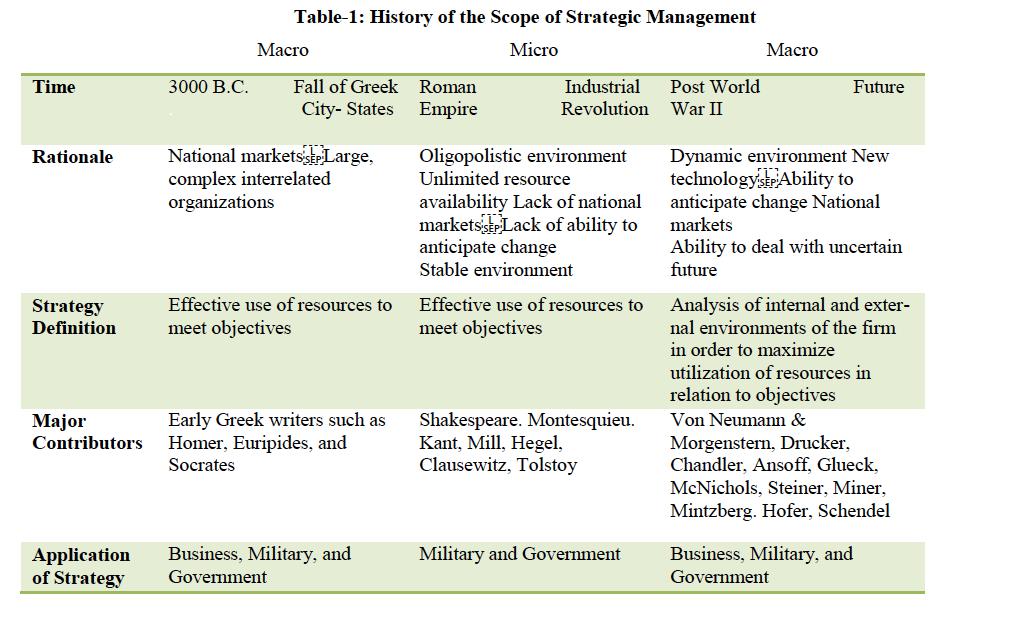
Strategic Management Tools
Strategic management tools are consist of SWOT analysis, customer satisfaction analysis, price analysis,
analysis of views and employee attitudes, cost-benefit analysis, analysis of customers complaints, analysis of
customers’ opinions and attitudes, Porter’s five forces, PEST analysis, level of service analysis, market
segmentation, market – share analysis, customer profitability analysis and benchmarking(Afonina, Chalupský,
2012).
Swot Analysis’ Definition, History And Swot Analysis In Strategic Management
Swot Analysis Definition
SWOT Analysis is (one of many possible strategic planning tools) used to evaluate the Strengths, Weakness,
Opportunities and Threats involved in a project, or any other situation requiring a decision and has been a useful
tool for industry. SWOTs are defined based on the following criteria:
Strengths are internal attributes of the organization that are helpful to the achievement of the objective.
Weaknesses are internal attributes of the organization that are harmful to the achievement of the objective.
Opportunities are external conditions that are helpful to the achievement of the objective.
Threats are external conditions that are harmful to the achievement of the objective.
In theory, SWOTs are used as inputs to the creative generation of possible strategies, by asking and answering
the following four questions numerous times:
How can we Use each Strength?
How can we Stop each Weakness?
How can we Exploit each Opportunity?
How can we Defend against each Threat?
(Hay, Castilla, 2006; Balamuralikrishna, Dugger, 1995).
SWOT analysis, also known as SWOT-matrix (Figure 2), is a decision tool for organizations and a method to
develop their understanding of certain situation. The acronym stands for strengths, weaknesses, opportunities
and threats(Pystynen,2016).
Strengths
Strengths are internal originating positive factors, which need to be maintained. For example if you are planning
to start a business, you or an employee or family member may have previous experience in that industry. If not,
this may be viewed as a weakness. If you already know where to go to find the help you need, this would be
considered a strength for this analysis.
Weaknesses
Weaknesses are also generally considered internal and are the factors you will need to address to run a
successful business. For a start-up business, an example might be a lack of experience in the selected industry.
Opportunities
Opportunities are external originating positive factors, which need to prioritized or captured. What opportunities
are available for your business? You may be able to take advantage of low interest loan packages for start-ups or
grants for feasibility studies.
Threats
Threats are external originating negative factors, which need to be countered or minimized and managed.
Threats from outside of your business will directly affect you, but you may have very little control over them.
Unforeseen competition (local or foreign), dissolution of markets, and adverse weather may also have a negative
effect on your business(USDA, 2008; Pystynen, 2016).
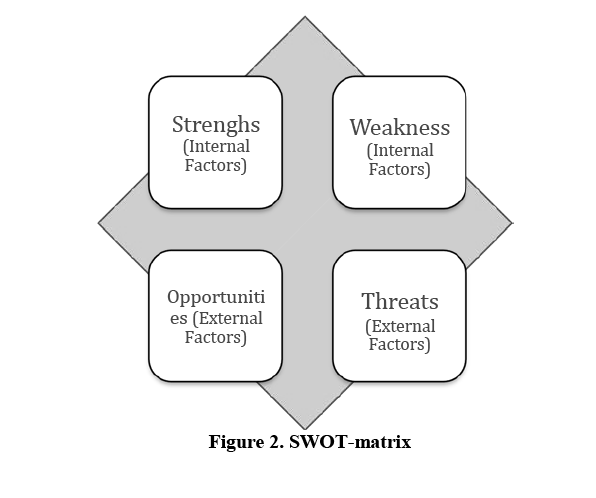
The origins of the SWOT analysis technique is credited by Albert Humphrey, who led a research project at
Stanford University in the 1960s and 1970s using data from many top companies. The major goal was to
identify why corporate planning failed? The resulting research identified a number of key areas and thus the tool
used to explore each of the critical areas was called Satisfactory, Opportunity, Fault and Threat (SOFT)
analysis. Humphrey and the original research team used the categories “What is good in the present is
satisfactory, good in the future is an opportunity; bad in the present is a fault and bad in the future is a threat.” In
1964 Urick and Orr at a conference changed the F to a W, and it has stuck as that, SOFT to SWOT. Some
researchers reference the 1965 publication “business Policy, text and cases” by Learned, Christensen, Andrews
and Guth from Harvard University, in which a framework is used which closely resembles SWOT, however
these words are not used and certainly the framework is not described as succinctly as we know it today(George,
Pramod, 2013; Shrestha, 2012; Fine, 2009; Zavadskas, Turskis, Tamosaitiene, 2011).
Swot Analysis Importance
The importance for managers of a rigorous and consistent situation analysis is indisputable, and a SWOT
analysis can provide a useful lens(Allio, 2006). Examining a company's internal and external environment is
essential in the process of strategic planning. The SWOT analysis, which includes the analysis of strengths,
weaknesses, opportunities and threats investigates both, internal and external as well as positive and negative
factors of a corporation. On the basis of the SWOT analysis a marketing strategy can be developed using
corporate strengths as well as avoiding corporate weaknesses to enable a company to benefit from future
opportunities with regard of future risks(B hm, 2009).
Benefits of Swot Analysis
The biggest benefit of SWOT analyses is that it focuses on both the inside and outside environment. It
complements this thesis by providing a closer look at the provided solution and the company itself. The main
advantages are identified in the method, but also some weak sides are discussed. This will help the company
looking for expansion to focus on its strengths and manage its the weaknesses. The threats can be from different
origins. In the method they are considered as barriers. The opportunities also take a part in the method. SWOT
analysis requires no extensive training or technical skills to be used successfully and specialized training and
skills are not necessary, the use of SWOT analysis can actually reduce the costs associated with strategic
planning(Koseva, 2012; Karg, Jahn, Ahrberg, 2014). SWOT analysis assumes a central position in business
management. The external (environmental analysis) and internal (analysis of the company) analyzes are always
seen in a mutual dependency relationship. This dependence expresses in the

Swot Analysis In Strategic Management
As you can see on the Figure 1., strategy begins with objectives, which naturally follow from a company's
mission that is the reason for being. Objectives are concrete goals that a company seeks to reach. They should
be challenging but achievable and measurable. To devise a strategic plan to achieve these objectives, a company
has to analyse its situation. The SWOT analysis is a tool for such a situation analysis. As commonly defined,
SWOT analysis is an approach to considering the inhibitors and enhancers to performance that an organization
encounters in both its internal and external environments. The basic assumption of a SWOT analysis is that a
company must align internal activities with external realities to be successful. The SWOT analysis provides a
framework for analysing strengths and weaknesses (internal), and opportunities and threats (external). It helps to
focus on strengths, to minimize weaknesses, and to take the greatest possible advantage of opportunities
available(Pahl, Richter, 2007; Leigh, Pershing, 2006).
INES 2016
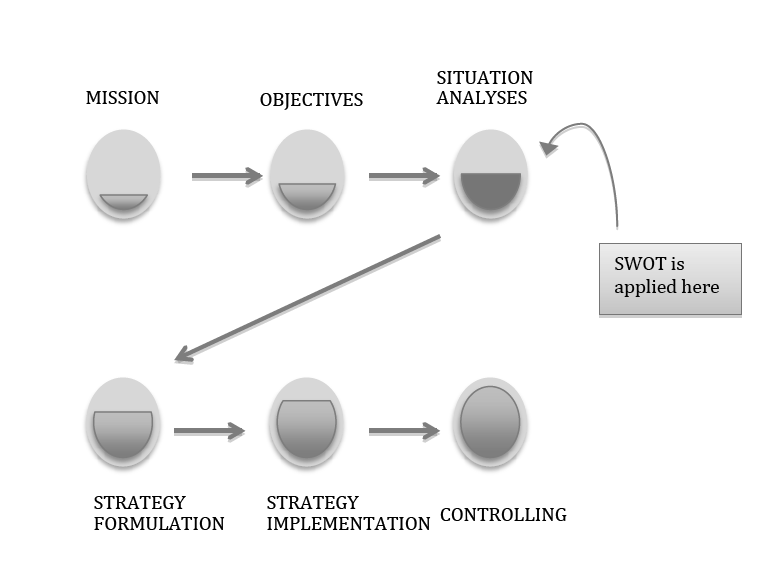
Figure 1. Strategic Planning Process
AN IMPLEMENTATION IN A MACHINE INDUSTRY FIRM
Data Collection Procedure
In this study, first of all, the related literature was reviewed and the necessary information was obtained in order
to form a theoretical basis. We observed the factory through strategic management perspective with production
managements and technicians. The required informations were gathered through face-to-face interviews with
the business managements and the other staff. And also we search the current market situation relating with the
company from statistical documents and studies.
Findings of the Study
This firm manufactures food machines for biscuit and cake sector in Karaman city. Staffs are consist of 20
people, all of them are qualified and expertise in their own work. Firms’ machine quality is high so there are few
complaints come from the customers. The company has some strengths relates with the staff, production style,
machines, software programs and other fixtures, expertise fields and finally administration. At the same time the
company has some weakness relates with production style, staff, machines, software programs and other
fixtures, administration, costs and incomes. Opportunities, the firm encounter, are relates with changing in
production styles, current markets, future trend for current market, new markets, state aids. The firm also
encounter threats relates with rivals, customers, current market structure and orders. All of them were mentioned
in the SWOT analyses as you can see at the Table-2. Generally the firm isn’t in a bad condition but they should
make some structural changes especially in the market positions and administration applications such as make a
vision and apply a strategic management. So they can perform the works as they do, with systematical approach.
General manager is open to change therefore the changes can perform so fast. It is a huge advantage for the firm
maybe it is the best advantage that they have. Production styles is in tendency of converting to assembly
manufacturing so the firm can evaluate to conduct a outsource applications easily. There will be lots of benefits
owing to these collaborations. State aids in Turkey are in high level currently therefore the company can use
these aids. These aids especially should be used in make an increase in exporting. Because in their sector the
competition is so high and the domestic market start to narrow. They should employ market stuff for performing
the marketing applications more professional and effective. As we search from the statistical document, food
and biscuit sector is in growing tendency in worldwide. Thanks to this dynamic, the company that we observed
through the strategic management, should use this opportunities immediately and make its location in the both
domestic and international area.
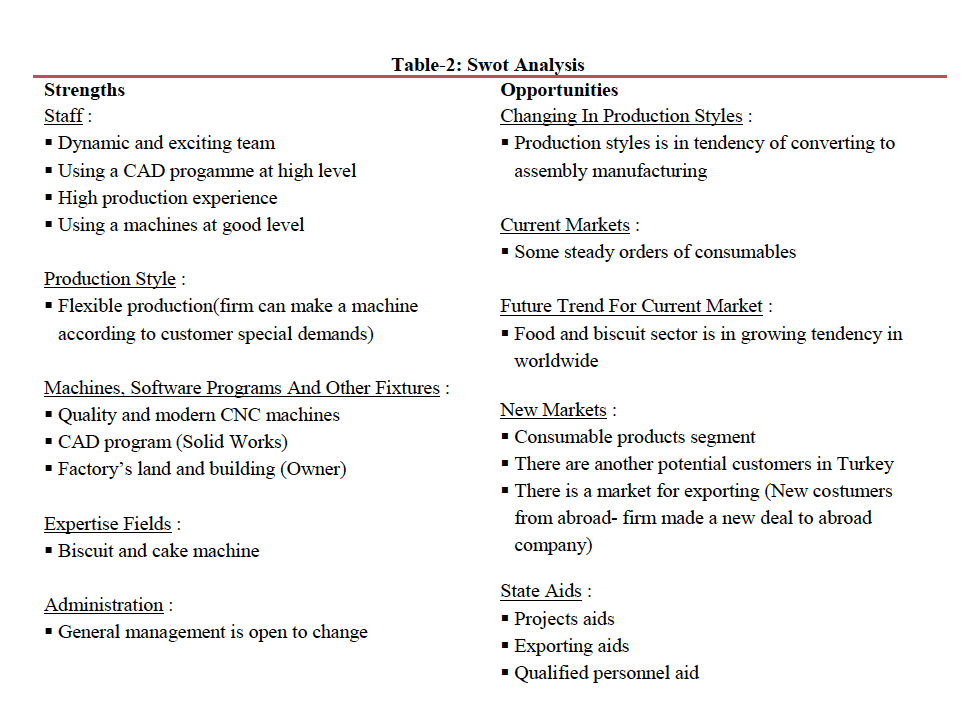
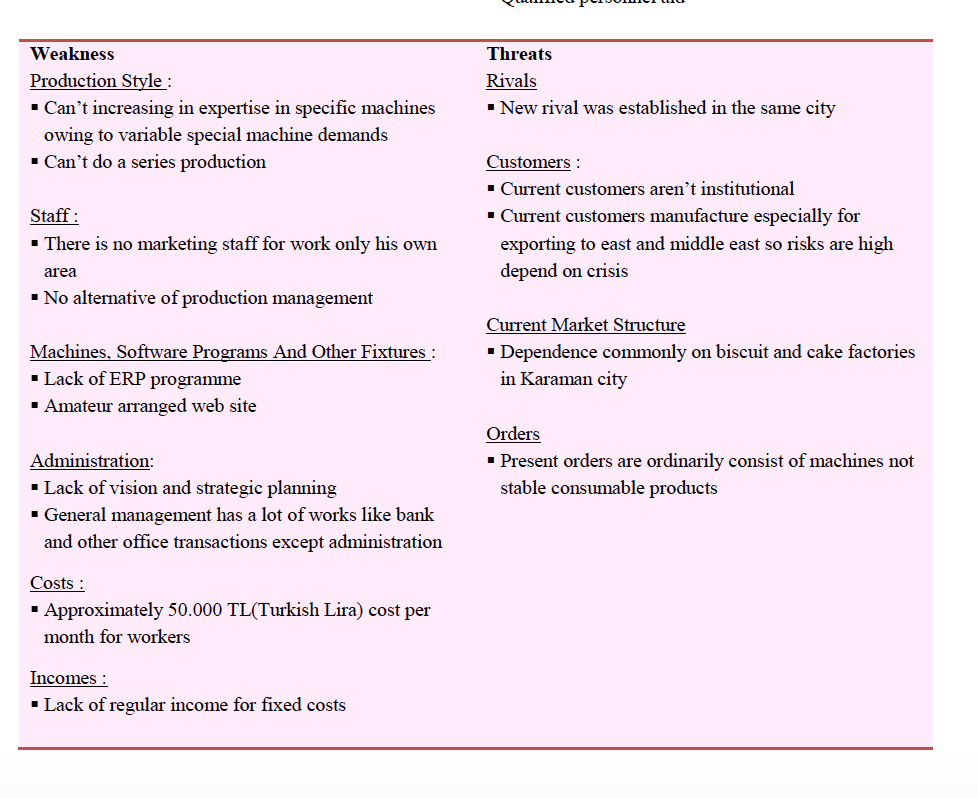
CONCLUSION
A framework that will guide businesses in managing complexity and interconnections of multiple and
diversified elements in their internal and external environments. The discipline of strategic management is
naturally evolving in the direction of systemic and comprehensive solutions(Witek, 2012). SWOT analysis is
the most used tools of strategic managements. SWOT analyses makes brief and effective picture of company’s
situation. But theorists and practitioners generally agree that the result of a SWOT analysis can lead to a quick
analysis of the situation, which remains approximate and incomplete(Speth, 2015). Therefore SWOT analysis’
findings should be used quickly in the subsequent stages of strategic management. This firm that we made
SWOT implementation, should start at make a vision , this is the most important finding and so evaluations and
studies should be start from there. After that they should make some structural changes such as using ERP,
employ a marketing stuff and make marketing department, then they should tend to international markets
because of the narrowing in the domestic market.
REFERENCES
Afonina, A., & Chalupský, V. (2012). The Current Strategic Management Tools And Techniques: The Evidence
From Czech Republic. Economics and Management, 17(4), 1535-1544.
Andrews, K. R. (1997). 5 The Concept Of Corporate Strategy. Resources, Firms, And Strategies: A Reader In
The Resource-Based Perspective, 52.
Allio, R. J. (2006). Strategic Thinking: The Ten Big Ideas. Strategy & Leadership, 34(4), 4-13.
Balamuralikrishna, R., & Dugger, J. C. (1995). SWOT Analysis--A Management Tool for Initiating New
Programs in Vocational Schools. Journal of Vocational and Technical Education, 12(1), 36-41.
Bracker, J. (1980). The Historical Development Of The Strategic Management Concept. Academy of
management review, 5(2), 219-224.
B hm, A. (2009). The SWOT Analysis (pp. 978-3640424191). GRIN Verlag.
Cao, Y., Zhao, K., Yang, J., & Xiong, W. (2015). Constructing The Integrated Strategic Performance Indicator
System For Manufacturing Companies. International Journal Of Production Research, 53(13), 4102-4116.
Chen, M.-J., Fairchild, G. B., Freeman, R. E., Harris, J. D., & Venkataraman, S. (2010). What is strategic
manage- ment? Darden Business Publishing, UVA-S-0166.
Fine, L. G. (2009). The SWOT analysis. Kick. It, LLC.
Gec kov a, I., & Papcunov b, V. (2014). Using Of Strategic Management Tools In Conditions Of Local Self-
Government In Slovakia. Procedia-Social And Behavioral Sciences, 110, 969-978.
George, J. P., & Pramod, V. R. (2013). SWOT Analysis of Steel Re Rolling Mills (A Comparative Study Of
International Brand With A Local Brand). International Journal of Scientific and Research Publications, 54.
Gü lü, N. (2003). Stratejik y netim. Gazi niversitesi Gazi � � � � � � � � � � � � � � � � � � � �, 23(2).
Hax, A. C., & Majluf, N. S. (1988). The Concept Of Strategy And The Strategy Formation Process. Interfaces,
18(3), 99-109.
Hay, G. J., & Castilla, G. (2006, July). Object-Based Image Analysis: Strengths, Weaknesses, Opportunities
And Threats (SWOT). In Proc. 1st Int. Conf. OBIA (pp. 4-5).
Karg, L., Jahn, C., & Ahrberg, M. (2014). Study On Successful And Potential Means Of Innovative
Networking. Alpine Energy Meetings on Advanced Technology Project, 57.
Koseva, I. I. (2012). Method That Supports E-Tendering Vendors To Enter The Bulgarian Public Market.
Thesis Research Report Master Business Informatics Utrecht University, 33.
Leigh, D., & Pershing, A. J. (2006). SWOT analysis. The Handbook of Human Performance Technology, 1089-
1108.
Liu, S. (1998). Strategic Scanning And Interpretation Revisiting: Foundations For A Software Agent Support
System-Part 1: Understanding The Concept And Context Of Strategic Scanning. Industrial Management &
Data Systems, 98(7), 295-312.
� � � � � � � � � � � � � � � � � � � � � � � � � Implementation As A Part Of Strategic Management.
Procedia-Social and Behavioral Sciences, 110, 861-870.
Pahl, N., & Richter, A. (2007). SWOT Analysis. Idea, Methodology And A Practical Approach. Scholarly
Research Paper, norderstedt, germany: grin verlag
Pricop, O. C. (2012). Critical Aspects In The Strategic Management Theory. Procedia-Social and Behavioral
Sciences, 58, 98-107.
Pystynen, H. (2016). Purchaser’s Role In The Early Supplier Involvement: A Case Study Of An Automotive
Tier 1 Company. Business Administration Bachelor’s Thesis, Laurea University of Applied Sciences, 16.
Shook, C. L., Ketchen, D. J., Hult, G. T. M., & Kacmar, K. M. (2004). An Assessment Of The Use Of
Structural Equation Modeling In Strategic Management Research. Strategic Management Journal, 25(4), 397-
404.
Shrestha, S. K. (2012). Swot Analysis Of Leather Shoes Markets In Nepal. Management Dynamics, 16(2), 62-
71.
Speth, C. 2015: “The SWOT analysis – Develop Strengths To Decrease The Weaknesses Of Your Business”.
50minutes.com. 12 p.
USDA (2008). SWOT Analysis A Tool For Making Better Business Decisions. United States Department of
Agriculture Risk Management Agency.
Witek-Crabb, A. (2012). Sustainable Strategic Management And Market Effectiveness Of Enterprises.
Procedia-Social and Behavioral Sciences, 58, 899-905.
Zavadskas, E. K., Turskis, Z., & Tamosaitiene, J. (2011). Selection Of Construction Enterprises Management
Strategy Based On The SWOT And Multi-Criteria Analysis. Archives Of Civil And Mechanical Engineering,
11(4), 1063-1082.
